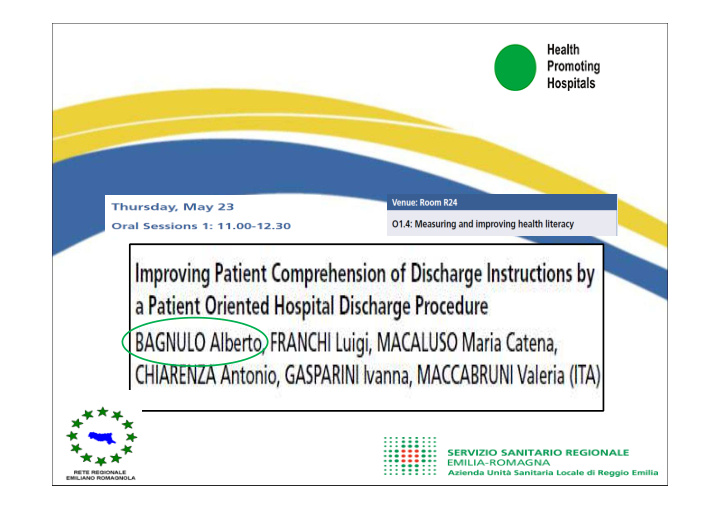



Correggio(lat.44° 53’00’’N; long.11° 43’00’’E)
SCENARIO FROM THE LITERATURE � Less than 60% of patients understand their discharge instructions � In elderly people transition care is associated with high rates of medication errors and unintentional medication discrepancies(low cognition at discharge is common; cognition often improves one month past hospitalization) � Almost 20% of hospitalized seniors are re-hospitalized within 30 days � Current discharge strategies may be ineffective but patient comprehension and recall of discharge instructions could be improved by supplementing free texts with pictographs within a standardized counseling at a low literacy level
SCENARIO FROM THE REAL LIFE � Over 80% of patients hospitalized into my ward has more than 70 ys. � More than 50% of these have some cognitive problems and a family caregiver � The discharge letter is for the primary care physician, not for the patient � COPD is the condition for which you have in our area the highest percentage of early re-hospitalizations
Hospitals in the Local Health Authority of Reggio Emilia: prevalence of re-admissions to 30 and 90 days for patients discharged during the first 9 months of 2011 Patients re- % of patients Patients re- % of patients Total number admitted re-admitted admitted re-admitted of patients Principal Diagnosis within 30 within 30 within 90 within 90 admitted days days days days Arrhythmia 263 30 11.4% 63 24.0% Cerebrovascular Diseases 1290 110 8.5% 211 16.4% 376 65 114 COPD 17.3% 30.3% Congestive Heart Failure 497 79 15.9% 143 28.8% Coronary Artery Disease 1074 167 15.5% 265 24.7% Diabetes 190 20 10.5% 42 22.1% Hypertension 324 32 9.9% 60 18.5% Pneumonia 806 87 10.8% 159 19.7% Renal Failure 245 33 13.5% 62 25.3%
PROCEDURE OF COUNSELING AT DISCHARGE THE DAY BEFORE DISCHARGE
PROCEDURE OF COUNSELING AT DISCHARGE THE DAY OF DISCHARGE
THESE ARE THE FOCUS 1. DIAGNOSIS 2. STAGE OF THE DISEASE STAGE OF THE DISEASE 2. 3. NAME OF MEDICATIONS/DOSAGE/MODE OF INTAKE/SIDE EFFECTS 4. NON PHARMACOLOGICAL THERAPY 5. LIFESTYLES 6. FOLLOW-UP
THESE ARE THE FOCUS 1. DIAGNOSIS 2. STAGE OF THE DISEASE 3. NAME OF MEDICATIONS/DOSAGE/MODE OF INTAKE/SIDE EFFECTS 4. NON PHARMACOLOGICAL THERAPY 5. LIFESTYLES 6. FOLLOW-UP
Discharge diagnosis(2):” acute/sudden worsening of your ability to breath/breathing with the appearance of hard to breath/cough/phlegm caused by Discharge diagnosis(1):” acute an infection/inflammation of your lungs respiratory failure from acute already sick of COPD” exacerbation of COPD in a patient with center- and pan-lobular enphysema” COPD is characterized by airflow obstruction,usually progressive, not changing markedly over several months
THESE ARE THE FOCUS 1. DIAGNOSIS 2. 2. STAGE OF THE DISEASE STAGE OF THE DISEASE 3. NAME OF MEDICATIONS/DOSAGE/MODE OF INTAKE/SIDE EFFECTS 4. NON PHARMACOLOGICAL THERAPY 5. LIFESTYLES 6. FOLLOW-UP
Add long-acting inhaled Active reduction of risk bronchodilators and factors,vaccinations,short- pulmonary rehabilitation acting inhaled bronchodilators Add inhaled corticosteroids Add Oxygen.Surgery?
THESE ARE THE FOCUS 1. DIAGNOSIS 2. 2. STAGE OF THE DISEASE STAGE OF THE DISEASE 3. NAME OF MEDICATIONS/DOSAGE/MODE OF INTAKE/SIDE EFFECTS 4. NON PHARMACOLOGICAL THERAPY 5. LIFESTYLES 6. FOLLOW-UP
long-acting corticosteroids bronchodilators short-acting antibiotics bronchodilators
Times of the drug intake
THESE ARE THE FOCUS 1. DIAGNOSIS 2. STAGE OF THE DISEASE STAGE OF THE DISEASE 2. 3. NAME OF MEDICATIONS/DOSAGE/MODE OF INTAKE/SIDE EFFECTS 4. NON PHARMACOLOGICAL THERAPY 5. LIFESTYLES 6. FOLLOW-UP
X _?_ hours
THESE ARE THE FOCUS 1. DIAGNOSIS 2. STAGE OF THE DISEASE STAGE OF THE DISEASE 2. 3. NAME OF MEDICATIONS/DOSAGE/MODE OF INTAKE/SIDE EFFECTS 4. NON PHARMACOLOGICAL THERAPY 5. LIFESTYLES 6. FOLLOW-UP
If y can quit smoking y can slow progression of COPD and by doing so increase your lifespan
THESE ARE THE FOCUS 1. DIAGNOSIS 2. STAGE OF THE DISEASE 2. STAGE OF THE DISEASE 3. NAME OF MEDICATIONS/DOSAGE/MODE OF INTAKE/SIDE EFFECTS 4. NON PHARMACOLOGICAL THERAPY 5. LIFESTYLES 6. FOLLOW-UP
COPD ASSESSMENT TEST(CAT) Short, simple questionnaire for monitoring long-term follow-up of COPD. Aimed at primary care practice. Validated in 3 international studies. 8 items, six-point scale, responds to exacerbations. Self-administered. Covers a wide range of symptoms.
bagnuloa@ausl.re.it
Recommend
More recommend